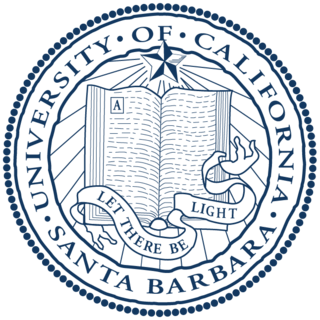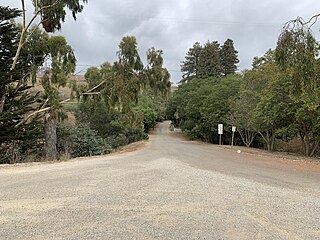Related Research Articles

The Federal Reserve System is the central banking system of the United States. It was created on December 23, 1913, with the enactment of the Federal Reserve Act, after a series of financial panics led to the desire for central control of the monetary system in order to alleviate financial crises. Over the years, events such as the Great Depression in the 1930s and the Great Recession during the 2000s have led to the expansion of the roles and responsibilities of the Federal Reserve System.

The Farm Credit Administration is an independent agency of the federal government of the United States. Its function is to regulate the financial institutions that provide credit to farmers.

Goleta is a city in southern Santa Barbara County, California, United States. It was incorporated as a city in 2002, after a long period as the largest unincorporated populated area in the county. As of the 2000 census, the census-designated place had a total population of 55,204. A significant portion of the census territory of 2000 did not incorporate into the new city. The population of Goleta was 32,690 at the 2020 census. It is known for being near the University of California, Santa Barbara, campus.

Isla Vista is an unincorporated community in Santa Barbara County, California, in the United States. As of 2020 census, the community had a population of 15,500. For statistical purposes, the United States Census Bureau has defined the community as a census-designated place (CDP). The majority of residents are college students at the University of California, Santa Barbara, or Santa Barbara City College. The beachside community of Isla Vista lies on a flat plateau about 30 feet (9 m) in elevation, separated from the beach by a bluff.

The University of California, Santa Barbara is a public land-grant research university in Santa Barbara, California, United States. It is part of the University of California university system. Tracing its roots back to 1891 as an independent teachers' college, UCSB joined the ancestor of the California State University system in 1909 and then moved over to the University of California system in 1944. It is the third-oldest undergraduate campus in the system, after UC Berkeley and UCLA. Total student enrollment for 2022 was 23,460 undergraduate and 2,961 graduate students.

A credit union is a member-owned nonprofit cooperative financial institution.
Vista usually refers to a distant view.

The National Credit Union Administration (NCUA) is an American government-backed insurer of credit unions in the United States, one of two agencies that provide deposit insurance to depositors in U.S. depository institutions, the other being the Federal Deposit Insurance Corporation, which insures commercial banks and savings institutions. The NCUA is an independent federal agency created by the United States Congress to regulate, charter, and supervise federal credit unions. With the backing of the full faith and credit of the U.S. government, the NCUA operates and manages the National Credit Union Share Insurance Fund, insuring the deposits of more than 124 million account holders in all federal credit unions and the overwhelming majority of state-chartered credit unions. Besides the Share Insurance Fund, the NCUA operates three other funds: the NCUA Operating Fund, the Central Liquidity Facility (CLF), and the Community Development Revolving Loan Fund (CDRLF). The NCUA Operating Fund, with the Share Insurance Fund, finances the agency's operations.
The Santa Barbara Student Housing Coop (SBSHC) is a student housing cooperative designed to provide affordable housing for students attending post-secondary institutions in Santa Barbara County. It is a member of NASCO. The first coop was established in 1976, and consists of five houses; Newman, Manley, Dolores, Biko and Merton. In all, just under 100 students live in these houses.
A community development financial institution (US) or community development finance institution (UK) - abbreviated in both cases to CDFI - is a financial institution that provides credit and financial services to underserved markets and populations, primarily in the USA but also in the UK. A CDFI may be a community development bank, a community development credit union (CDCU), a community development loan fund (CDLF), a community development venture capital fund (CDVC), a microenterprise development loan fund, or a community development corporation.
SS Mission Santa Barbara was a Type T2-SE-A2 tanker built for the United States Maritime Commission during World War II. After the war she was acquired by the United States Navy as USS Mission Santa Barbara (AO-131). Later the tanker transferred to the Military Sea Transportation Service as USNS Mission Santa Barbara (T-AO-131). She was a Mission Buenaventura-class oiler and was named for Mission Santa Barbara in Santa Barbara, California.

The Federal Home Loan Bank Act, Pub. L.Tooltip Public Law 72–304, 47 Stat. 725, enacted July 22, 1932, is a United States federal law passed under President Herbert Hoover in order to lower the cost of home ownership. It established the Federal Home Loan Bank Board to charter and supervise federal savings and loan institutions. It also created the Federal Home Loan Banks which lend to building and loan associations, cooperative banks, homestead associations, insurance companies, savings banks, community development financial institutions, and insured depository institutions in order to finance home mortgages.
Pentagon Federal Credit Union, widely known by its abbreviated name PenFed, is a United States federal credit union headquartered in McLean, Virginia, chartered and regulated under the authority of the National Credit Union Administration (NCUA). PenFed is the nation's third largest federal credit union, with assets of $25 billion and more than 1.8 million members as of July 2018.
Bank regulation in the United States is highly fragmented compared with other G10 countries, where most countries have only one bank regulator. In the U.S., banking is regulated at both the federal and state level. Depending on the type of charter a banking organization has and on its organizational structure, it may be subject to numerous federal and state banking regulations. Apart from the bank regulatory agencies the U.S. maintains separate securities, commodities, and insurance regulatory agencies at the federal and state level, unlike Japan and the United Kingdom. Bank examiners are generally employed to supervise banks and to ensure compliance with regulations.

Credit unions in the United States served 100 million members, comprising 43.7% of the economically active population, in 2014. U.S. credit unions are not-for-profit, cooperative, tax-exempt organizations. The clients of the credit unions become partners of the financial institution and their presence focuses in certain neighborhoods because they center their services in one specific community. As of March 2020, the largest American credit union was Navy Federal Credit Union, serving U.S. Department of Defense employees, contractors, and families of servicepeople, with over $125 billion in assets and over 9.1 million members. Total credit union assets in the U.S. reached $1 trillion as of March 2012. Approximately 236,000 people were directly employed by credit unions per data derived from the 2012 National Credit Union Administration (NCUA) Credit Union Directory. As of 2019, there were 5,236 federally insured credit unions with 120.4 million members, and deposits of $1.22 trillion.
The Isla Vista Municipal Advisory Council was a local government agency in the Isla Vista district of Santa Barbara County, California. It was among the first Municipal Advisory Councils of California, elected representative bodies created in 1970/1971 in certain localities in response to race riots.
The University of California, Santa Barbara (UCSB) traces its roots back to the 19th century, when it emerged from the Santa Barbara School District, which was formed in 1866 and celebrated its 145th anniversary in 2011. UCSB's earliest predecessor was the Anna S. C. Blake Manual Training School, named after Anna S. C. Blake, a sloyd-school which was established in 1891. From there, the school underwent several transformations, most notably its takeover by the University of California system in 1944.

A public bank is a bank, a financial institution, in which a state, municipality, or public actors are the owners. It is an enterprise under government control. Prominent among current public banking models are the Bank of North Dakota, the Sparkassen-Finanzgruppe in Germany, and many nations’ postal bank systems.
Rogue Credit Union, formerly Rogue Federal Credit Union, is an American Oregon State chartered credit union and financial holding company headquartered in Medford, Oregon, United States. As of 2022, the credit union's assets are $3.70 billion USD. Rogue Credit Union's branch network serves Southwest Oregon counties of Coos, Curry, Douglas, Jackson, Josephine, Malheur and Klamath County, as well as Payette County in Idaho and Del Norte County, California.

Naples is an unincorporated area in Santa Barbara County, California, United States on the south portion of the Gaviota Coast. Also known as Dos Pueblos Ranch, it is located on U.S. Highway 101 5.9 miles (9.5 km) west-northwest of Isla Vista.
References
- ↑ "Overview of Federal Credit Unions". National Credit Union Administration. April 14, 2022.
- ↑ "Daily Nexus -Variety of Community Services Available at i.V. Service Center". University of California, Santa Barbara. January 26, 1977. p. 6.
- ↑ The Goleta Sun 12-10-77